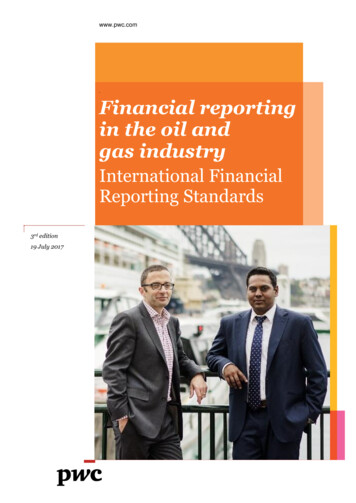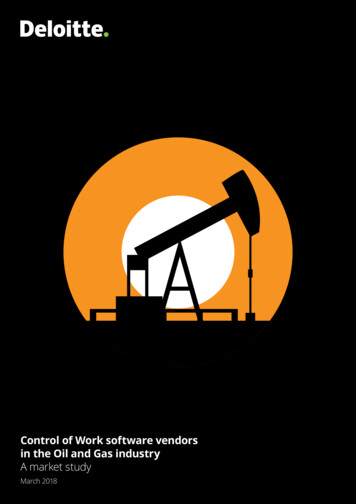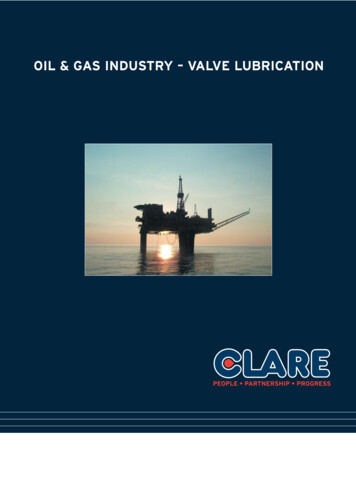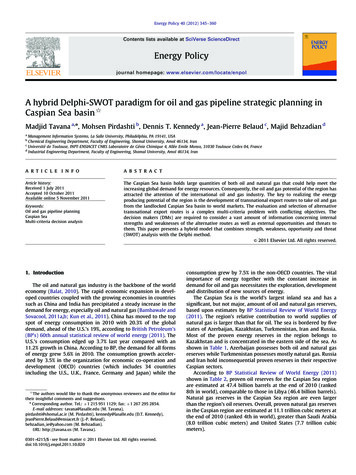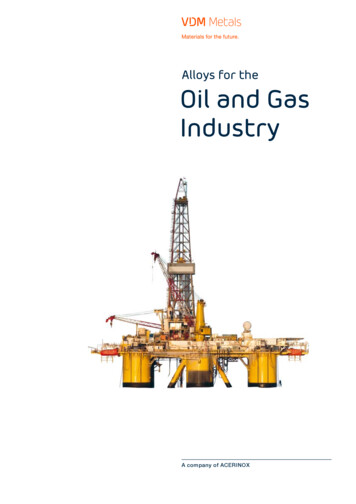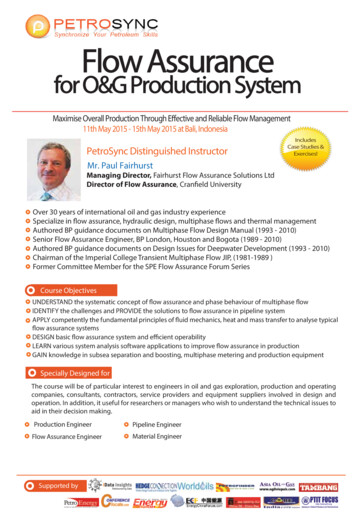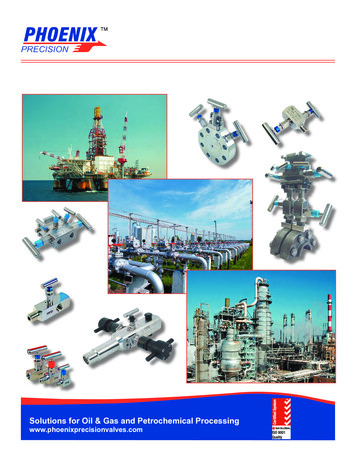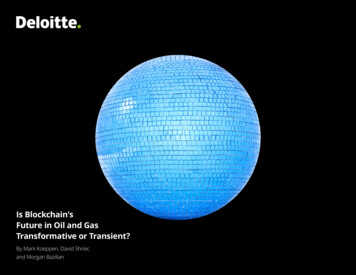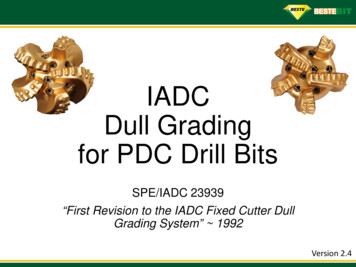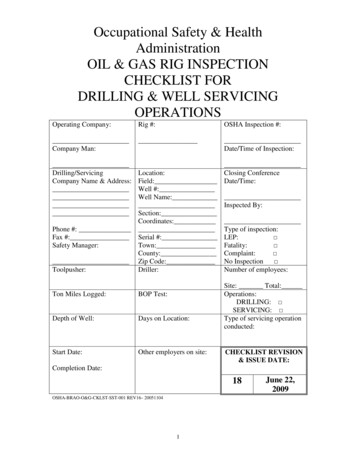
Transcription
Occupational Safety & HealthAdministrationOIL & GAS RIG INSPECTIONCHECKLIST FORDRILLING & WELL SERVICINGOPERATIONSOperating Company:Rig #:OSHA Inspection #:Company Man:Date/Time of Inspection:Drilling/ServicingCompany Name & Address:Location:Closing ConferenceField: Date/Time:Well #:Well Name:Inspected By:Section:Coordinates:Type of inspection: Serial #: LEP: Town: Fatality:County: Complaint: Zip Code: No Inspection Driller:Number of employees:Phone #:Fax #:Safety Manager:Toolpusher:Ton Miles Logged:BOP Test:Depth of Well:Days on Location:Start Date:Other employers on site:Site: Total:Operations:DRILLING: SERVICING: Type of servicing operationconducted:CHECKLIST REVISION& ISSUE DATE:Completion Date:18OSHA-BRAO-O&G-CKLST-SST-001 REV16– 200511041June 22,2009
Purpose:This checklist is a product of the Occupational Safety & Health Administration, Baton Rouge Area Office, in conjunctionwith the OSHA Region 6 Regional Emphasis Program (REP or LEP) for the Oil & Gas Industry.The checklist combines the applicable requirements of 29 CFR 1910, American National Standards Institute (ANSI)Standards, American Petroleum Institute Recommended Practice 54 (API RP54), other more specific American Petroleum InstituteRecommended Practices, and the current and previous checklists for drilling and well servicing rigs generated by the InternationalAssociation of Drilling Contractors (IADC) and the Association of Energy Service Companies (AESC).This checklist is not all inclusive, but is intended to provide a clear and consistent inspection approach for inspectingdrilling and servicing rigs during REP/LEP inspections conducted by OSHA, but may also be used for Complaint & FatalityInvestigations. It is also intended for guidance and use by the numerous employers during their day-to-day inspections of their rigs,and for the post-LEP inspection dissemination of information to other rigs, branches, divisions, etc of the employer’s organization.The overall goal of the checklist is to assure that all employees working at Oil & Gas sites are provided a safe and healthy workenvironment in an extremely dangerous industry.This checklist shall be updated, as required, to keep up with advances in technology, changes in the industry and generalupdates to the contents of the checklist. Therefore, OSHA requests that all interested parties submit suggestions and recommendationsto improve this checklist at any time to the Baton Rouge Area Office of OSHA, 9100 Bluebonnet Centre, Suite 201, Baton Rouge LA70809.References:29 CFR 1910, Code of Federal Regulations, Safety & Health Regulations for General Industry29 CFR 1926, Subpart P, Code of Federal Regulations, Safety & Health Regulations for Construction, Excavations and TrenchingAPI Spec 4F, Specification for Drilling & Well Servicing Structures, 2nd Edition - 2001API RP 4G, Recommended Practice for Maintenance & Use of Drilling and Well Servicing Structures, 3rdEdition - 2004API RP 9B, Recommended Practice on Application, Care and Use of Wire Rope for Oilfield Service, 11th Edition - 2002API RP 49, Recommended Practice for Drilling and Well Servicing Operations Involving Hydrogen Sulfide, 2nd Edition - 2001API RP 53, Recommended Practice for Blowout Prevention Equipment Systems for Drilling Wells, 3rd Edition - 1997API RP 54, Recommended Practice for Safety & Health for Oil & Gas Well Drilling and Servicing Operations, 3rd Edition – 1999.API RP 67, Recommended Practices for Oilfield Explosives Safety. 1st Edition – 1994.API RP 68, Recommended Practice for Oil & Gas Well Servicing and Workover Operations Involving Hydrogen Sulfide, 1st Edition 1998API RP 500, Recommended Practice for Classification of Locations for Electrical Installations at Petroleum Facilities, 2nd Edition –1997API RP 2003, Protection against Ignitions Arising out of Static, Lightning, and Stray Currents, 6th Edition – 1998.ANSI B30.*, American National Standards Institute, Various crane (*type) standardsANSI B56.1, American National Standards Institute, Safety Standard for Low Lift and High Lift Trucks, 1993 editionANSI B56.6, American National Standards Institute, Safety Standard for Rough Terrain Forklift Trucks, 2002 EditionANSI Z358.1, American National Standards Institute, Emergency Eyewash & Shower Equipment, 2004 Edition.Legend:SAT – Satisfactory Condition or “Yes” ResponseUNS – Unsatisfactory Condition or “No” ResponseN/A – Not applicableDSB – Condition applies to (D)rilling, (S)ervicing or (B)oth in general, but may not apply to a specific site.CDI – Unsatisfactory condition that was corrected during the inspection or within 24 hours after the completion of the inspection.Standard – Applicable OSHA, API, ANSI or other government or industry recognized standard.Highlighted Condition Description – Applicable to environments containing Hydrogen Sulfide (H2S) and/or Sulfur Dioxide (SO2)ONLY.Disclaimers:This information has been developed by OSHA and is intended to assist employers, workers, and others as they strive to improveworkplace safety & health. While we attempt to thoroughly address specific topics and/or hazards, it is not possible to includediscussion of everything necessary to ensure a healthy and safe working environment. Thus, this information must be understoodas a tool for addressing workplace hazards, rather than an exhaustive statement of an employer’s legal obligations, which aredefined by statute, regulations and standards. Likewise, to the extent that this information references practices or procedures thatmay enhance health or safety, it cannot, and does not create additional legal obligations. Finally, over time, OSHA may modifyrules and interpretations in light of new technology, information or circumstances; to keep apprised of such developments, or toreview information on a wide range of occupational safety and health topics, you can visit OSHA’s website at www.osha.gov.Inspection results documented by this completed check list are valid only for this inspection and are not valid indicators of past orfuture inspection history of the employer.Distribution of this check list is unlimited – OSHA, Employers, & Industry Groups2
Summary of Changes to this RevisionCHECKLISTID #-LINEITEM#-PAGE#--2114416, 7, 8, 241a, 5a, 6a, 7,8a, 8b47a5, 5a, 6, 6a,7, 7a, 8, 8a,8b2422, 2a, 20, 25523A2b, 2c, 2d,4a2, 2a, 2b, 2c,2d, 4a5, 8, 12,133AREVISION#Change Revision number and date issuedAdded additional standard references – API RP49, API RP 67 & API RP68.Deleted standard reference for RP55Added additional description in the legend where the condition description ishighlighted.Change standard references for RP55 to RP49Added entire new lines1616444Added additional standard referenceLine number changed from 7 to 7aLines highlighted to indicate that they only apply when H2S is present.Additional standard references added.1616165165Line highlighted to indicate that they only apply when H2S is present.Additional standard references added.Change standard references for RP55 to RP49 and added new standardreferences for RP68.Added entire new lines5Lines highlighted to indicate that they only apply when H2S is present.166Added new or additional standard references.1666163A14, 156Added new standard reference. Added “High Pressure Lines, Etc” toCondition descriptionAdded entire new lines3C558181010Added additional standard referenceChange checklist titleAdded “100 ft from wellhead” to the condition description161616510A-B,31A-B, 32,334, 9, 10, 10A,11, 24, 26,31A, 31B1788a1a10-11Added entire new lines1610-11Added location choice check off box161616161611125566712DESCRIPTION OF CHANGE101212131616161616168214Added new standard referenceAdded additional standard referenceAdded entire new lineAdded entire new line and highlighted to indicate that it only applies whenH2S is presentAdded additional standard reference104217Added new standard reference16111212166a, 6b33a3182020231616161617181819191923-291a71, 1a3,4,5,6,7,9,11152425252525-6262020A4, 5272720B20C20C20H20I-K12a, 16a11a, 1b, 105, 6-2828282929-30Added entire new linesAdded “and installed properly” to the condition descriptionAdded entire new lineAdded “explosives” into the condition description. Added additional standardreference.Reference to RP55 deleted in standard columnAdded entire new lineAdded additional standard referenceAdded additional standard referencesAdded additional standard referencesAdded additional standard references. Added “, detonators or other initiationdevices contained” into condition description.Description of Special Services modifiedLines highlighted to indicate that they only apply when H2S is present.Additional standard references added.Added entire new linesAdded additional standard referenceAdded entire new linesAdded entire new linesAdded entire new sections31616161616161616161616161616
1.#DRILL SITE/LOCATIONSection N/A:ConditionS U N D C StandardA N / S DT S A B I1Authorized Personnel Sign Posted at entrance to siteB1aVisible rig identification sign erected at entrance to site roadand at all directional changes on site road (for 911 services)Hard Hat/Safety Glasses/Steel Toe Shoe Signs Posted atentrance to site and other prominent locations on siteNo Smoking Area’s Designated & PostedB1910.145(c)(2)(i)RP54 7.1.2-31910.151(a)B1910.145(c)(3)BNo Parking within 100 ft of the rig or within the guywireperimeter Vehicles not involved in immediate operationsBRP54 7.1.2-31910.145(c)(2)(i)RP54 6.1.15RP49 8.1234should be located 100 feet (30.5m) from the well bore.5H2S/SO2 warning signs erected, if applicable, at entrance to siteand at other prominent locations on siteB5a6Terrain evaluated for H2S/SO2.H2S/SO2 monitoring devices in use, if applicableBB6a7H2S monitoring equipment properly maintained & calibratedPositive pressure/pressure demand breathing apparatus with fullface piece used while working in areas where atmosphericconcentrations exceed 10 ppm (H2S) or 2 ppm (SO2)Emergency escape air packs and life lines are readily andquickly available, if applicableBBB1910.134(d)(2)(i)RP49 6.6.2Emergency escape air packs properly maintained and fullychargedEmergency escape air packs stored in a convenient, clean andsanitary locationStandby person qualified in first aid and CPR with suitablerescue equip. & appropriate breathing apparatus providedEscape & Guy wires flagged with visible materialCapacity of guywire anchors verified Base Beam Anchor Screw-type Anchor Permanent (Cement) Anchor OtherVerification Method:Outhouse/restroom facility provided or in close proximity to thesite. (LT 10 min travel time or 2 miles, whichever is less)(Facility in close proximity only applies if the site is active forless than 1 day)Outhouse clean and sanitary, if provided.Hard hats & Safety glasses available for visitorsToolpusher’s trailer groundedToolpusher’s trailer securely positionedHousekeepingBRP49 6.6.2BRP49 6.6.2BBBcurrently in draftASNI Z 390 3.4.2RP4G 14.5.fRP4G 14.1-4B1910.141(c)(1)(i)BBBBBDistance from overhead powerlines GT 10 ftToolpusher at rig locationMuster area designatedMuster area postedVisitor tracking system.Sign posted directing visitors to report to the site office uponentryWarning signs clean and visibleBBBBBB1910.142(d)(10)1910.132(a)RP54 6.1.16RP54 6.1.161910.22(a)(1)RP54 6.5.1RP54 .145(c)(2)(i)1910.1000(e)1910.1200(f)(5-6)RP49 5.1RP49 8.11910.1000(e)RP49 6.2-3RP49 6.5RP49 6.6.1RP49 5(c)(3)1910.1200(f)(9)
212223242526272.#All vessels labeled as to their contentsWork areas should be maintained clean and free of debris andtripping hazards.Crew change house cleanBBWind Sock, wind streamer, etc. placed in readily visible pointson the location. .Evacuation/All-clear alarmsHazardous locations identifiedRig substructure, derrick/mast, and other equipment asappropriate grounded to prevent accumulation of static chargeB1910.1200(f)(4-5)1910.22(a)(1)RP54 6.5.11910.22(a)(1)RP54 6.5.1RP49 8.2.3BBB1910.38(d)1910.1200(f)(5-6)RP54 6.1.16BTRAINING, PPE & GENERAL SAFETYConditionSection N/A:S U N D C StandardA N / S DT S A B I1First Aid Training providedB1a2Certification Card(s) availableH2S Training provided, if applicableBBRP49 5.1-62aCertification Card(s) availableBRP49 5.62bH2S training documentation of rig personnel availableBRP49 5.62c2dOnsite H2S safety review conductedH2S training drills conducted on a regular basisBBRP 49 10.2RP49 7.9, 10.73BRP54 6.1.73a3b3c3d3e4567Regularly scheduled and impromptu meetings of the crew, inwhich the probable hazards, problems of the job, and relatedsafe practices are emphasized and discussed.Weekly safety meeting being conductedSpecial safety meetings conducted when H2S/SO2 presentSafety meetings properly documentedAccidents, if any, are discussed during safety meetingsPre-Job safety meeting heldOSHA poster postedPre-Job safety meeting heldSafety equipment availableProper clothing worn by crew (No loose clothing).BBBBBBBBBRP54 6.1.7RP49 11.10.1bRP54 6.1.7RP54 6.1.7RP54 6.1.71903.2(a)(1)8Hard hats used by crewB9Eye protection as appropriate for the work being done should beworn by personnel.Hard toed shoes used by crewBJewelry or other adornment subject to snagging of hangingshould not be worn in the work area.Fall protection used, when requiredNo Smoking rules observedOSHA Log available on location. accidents duringcurrent yearInjuries reported and documented immediatelyFirst Aid Kit/Bloodborne Pathogen Kit available on siteBCommunications equipment should be in good working orderbefore commencing 4 4.3.11910.132(a)RP54 5.2.5RP54 5.2.61910.132(a)RP54 5.2.11910.135(a)(1-2)RP54 5.2.21910.133(a)(1-5)RP54 5.2.31910.136(a)RP54 5.2.7RP54 5.5.1RP54 7.1.31904.29(a-b)1904.40(a-b)RP54 4.1.1-21910.151(b)RP54 4.3.2RP 54 12.3.3
17Emergency phone numbers postedB17aB1819Provisions made for
API RP 500, Recommended Practice for Classification of Locations for Electrical Installations at Petroleum Facilities, 2: nd : Edition – 1997 : API RP 2003, Protection against Ignitions Arising out of Static, Lightning, and Stray Currents, 6: th: Edition – 1998. ANSI B30.*, American National Standards Institute, Various crane (*type) standards : ANSI B56.1, American National Standards .


